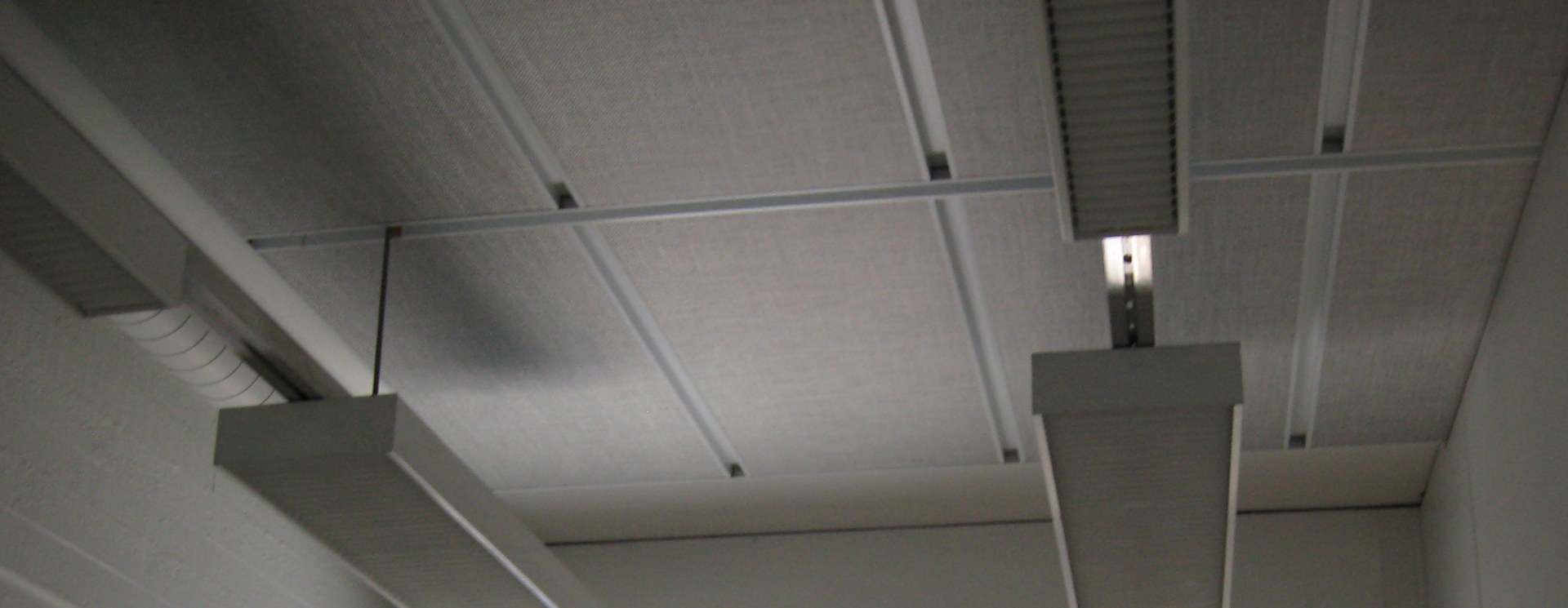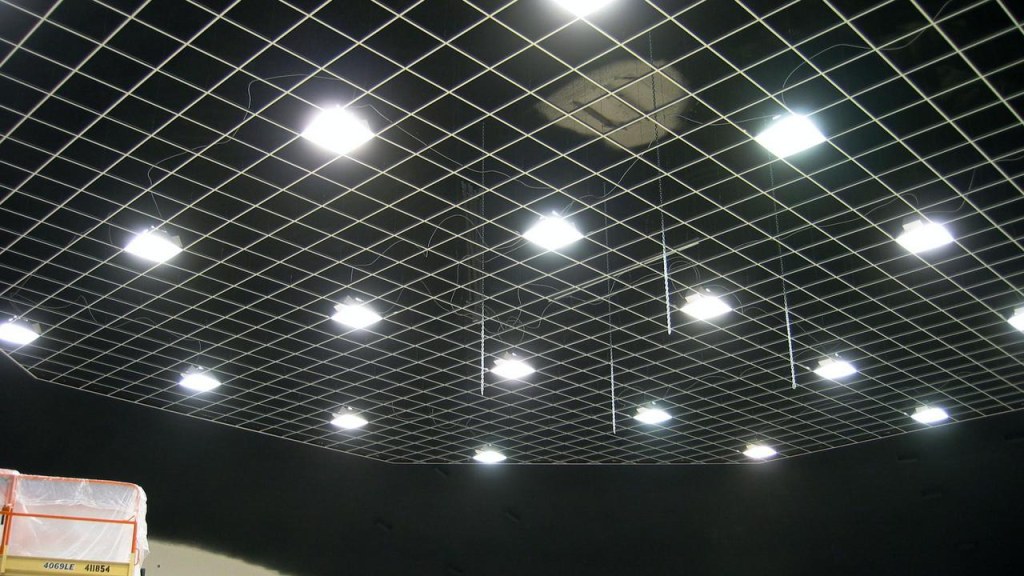
Suspended ceilings, also called false ceilings or drop ceilings, are constructed of a suspended grid that’s fitted with enough panels to completely cover the overhead space. It’s a pretty simple concept, but there are great reasons they’ve remained around so long.
Suspended ceilings serve a number of purposes well. They hide overhead eyesores, allow for easy access to overhead systems, and can even improve the sound in troublesome spaces. Combine these features with fantastic aesthetics, and you’ve got a winner.
You’ve undoubtedly seen drop ceilings in office spaces and schools over the years, but times have changed, and we’re putting them in all kinds of higher end spaces. That’s partly due to their great utility, and partly because we’ve got so many awesome options these days.
Getting to know this misunderstood ceiling type will familiarize you with the many styles and benefits, and may even sway your decision when it comes time to complete your next project.
What are Suspended Ceilings?
As we mentioned briefly, suspended ceilings are simply grids and tiles suspended from the overhead structure. The grid, known as a T-grid, is suspended from the true ceiling with rails, wires, or cables. This T-grid is laid out so standard ceiling tiles can be easily laid into the empty spaces between rails.
There are many unique combinations you could choose, but they’re all based on the same principles. This unique style of construction delivers both pros and cons.
Suspended Ceilings: Ceiling Pros and Cons
Like any ceiling type, some aspects will work well for your space, while others don’t necessarily fit the bill. It’s important to consider the dimensions of the space, how the room is used, and what type of performance you want out of your ceiling before making any decisions. Here are some things you can expect out of most suspended ceilings.
Drop Ceilings Benefits
I always like to begin on a positive note. Before we dig into the disadvantages, we’ll examine some of the benefits that go along with choosing suspended ceilings for your commercial and residential spaces. There are a number of them, so grab a glass and get comfortable.
They Hide Overhead Systems
The first benefit has to do with the plenum, or empty space between suspended ceilings and the true ceilings above them. This space allows suspended ceilings to hide exposed MEP (mechanical, electrical, and plumbing) systems that run overhead. This means you don’t have to clean and coat them regularly for aesthetic reasons. Hiding MEP systems is one reason suspended ceilings in commercial buildings have been popular choices for decades.
They Allow for Easy Access to Overhead Systems
In addition to hiding the MEP systems that reside overhead, suspended ceilings also allow us to access them without much trouble. When we completely seal a ceiling with drywall or wood, we can’t easily access anything overhead without getting into large construction projects.
With a drop ceiling, you can simply remove a panel, do the work, and re-cover your point of entry. No cutting, taping, or painting is involved. If you frequently make changes to the space, this kind of frustration free access is a game changer.
They Can Reduce Noise from Overhead Utilities
If you choose to use acoustical panels, that space will also prevent you from hearing any noise associated with those MEP systems. Each of them produces some noise during normal operation, which can spell trouble when it comes to conversations.
By utilizing acoustical panels, the sounds created by these overhead MEP systems may never make it into the room below. Acoustical tiles do a fantastic job of absorbing and reflecting sound waves back into the plenum. This keeps them from creating excess noise and interfering with our conversations and quiet time.
They Can Improve Acoustics
Another thing that acoustical panels can improve upon is the acoustics below the ceiling. Since sound waves have a tendency to continuously reflect off smooth surfaces and build up in rooms, absorbing them is a crucial part of improving the acoustics. Acoustical panels do just that.
By turning your ceiling into a porous, absorbent surface, you allow it to trap sound waves rather than reflect them. This improves sound quality by reducing the echo and reverberation that can make simple communication a whole lot more difficult. You’ll be surprised at what a profound impact you can experience by turning one of the largest reflective surfaces in the room into an absorbent one instead.
They Can Improve Energy Efficiency
Since suspended ceilings effectively reduce the height of the room, they allow warm air to remain in the bottom portion with the people living or working there. When heat rises in rooms with high ceilings, the warmer air sometimes just sits at the top of the room. That means we’ve got to turn the heat up to keep the people warm below. By keeping the warm air exactly where we want it, we lower our heating bills and do something good for the planet at the same time.
They’re Cost Effective for Remodels
When we’re doing room remodels, drop ceilings are an incredibly cost effective means of replacing the ceiling. First, you can save considerable money on labor. They are easy enough to install that you can make it a DIY project with a couple of friends over the weekend.
In addition to the money you’ll save on labor, suspended ceilings provide the benefit of allowing you to change your mind as much as you like without paying for someone to tear the ceiling apart and run new wires or pipes each time. For those who change their minds a lot, this fact alone may sell the drop ceiling as a viable choice.
They’re Available in Many Colors and Textures
Another benefit of going with suspended ceilings is their versatility. No matter what type of design scheme you’re after, there are panels to match your sensibilities. Since most are available in standard sizes, you can change your mind any time you’d like, and can even mix and match if you like.

Drop Ceilings Disadvantages
Even with all the benefits that go along with suspended ceilings, there are some disadvantages to discuss. Familiarizing yourself with these factors before making your decision will help you avoid potential downsides.
They Make Rooms Feel Shorter
We previously listed this fact as a benefit, so what gives? While there are advantages to bringing many ceilings down a bit, this doesn’t work well if the true ceiling is already fairly low. Installing suspended ceilings in places like basements or other rooms with particularly low ceilings can cause the space to feel cramped and claustrophobic. If you want to go with a drop ceiling, make sure you’ve got the overhead clearance to make it work.
They’re Not as Sturdy as Traditional Ceilings
Since they’re created by fitting a grid with free-floating panels, suspended ceilings are not quite as sturdy as traditional ceilings are. That means that if you live in an area prone to earthquakes, hurricanes, or tornadoes, they may not provide the level of protection you’re after during a natural disaster. That said, there are ways to create suspended ceilings that hold up better to abuse than others. You just need to know what you’re after.
They Can Deteriorate Faster than Traditional Ceilings
In addition to being less structurally sound, drop ceilings can deteriorate more quickly than traditional ceilings. This is especially true if you go with panels on the cheaper end of the spectrum or live in a particularly humid climate.
You can get extended life out of them by going with higher quality panels, but be aware that you will have to perform some routine maintenance to keep them looking great for the long haul.
They Alter Your Available Lighting Options
Since the entire surface is suspended so far below the true ceiling overhead, you’ve got to get creative when designing your lighting with suspended ceilings. Some options will be hard to pull off, while others may be off the table entirely. Before you choose to go with drop ceilings, make sure you understand the implications when it comes to lighting.
The Takeaway
All in all, suspended ceilings can be fantastic options for both commercial and residential buildings. They deliver a host of benefits with relatively few downsides. Commercial drop ceilings have been popular for years, and residential building applications are rapidly gaining in popularity. They allow us to hide MEP systems and help improve energy efficiency. The specific benefits we gain with suspended ceilings really depends upon the type of tiles we choose.
Acoustical panels will hide overhead noise and even improve the sound below. Other materials may be more suited to resisting moisture and mildew. You can even get microperforated panels that accomplish all of the above. The main variable you need to get right for a great drop ceiling is using quality materials.
We don’t get the best suspended ceilings by going with mediocre materials. We’ve got to choose quality. Going with a reputable dealer will not only provide you with the quality materials you desire, but with the years of expertise you need to ensure you get the job done right the first time. Reach out when you’re ready for a consultation.




